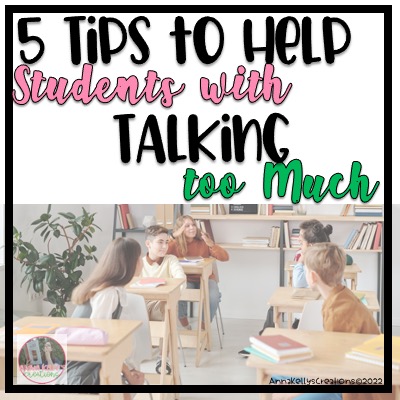“Please stop talking” “You should be working silently on this task” “We need to be respectful to our classmates and not talk while others are talking”
 Have you found yourself saying phrases similar to these lately? Do you feel like your students never stop talking? As the year progresses and the honeymoon period starts to disappear, students become more and more comfortable talking during class. Especially in a science classroom such as mine where the tables are grouped. It is much easier to do fun and engaging science activities when students are seated in groups, but this does not help with chattiness. These techniques help me to stop students from talking too much and gain classroom control.
Have you found yourself saying phrases similar to these lately? Do you feel like your students never stop talking? As the year progresses and the honeymoon period starts to disappear, students become more and more comfortable talking during class. Especially in a science classroom such as mine where the tables are grouped. It is much easier to do fun and engaging science activities when students are seated in groups, but this does not help with chattiness. These techniques help me to stop students from talking too much and gain classroom control.
#1 Have clear expectations and repeat OFTEN:
One way to help stop students from talking too much is to repeat expectations. We all start out the year, laying out classroom expectations, going over them and rehearsing them. But how often do you refer back and practice these expectations throughout the year? One strategy I have found to be very helpful is to follow the Whole Brain Teaching philosophy which is to review and practice rules daily, and have them clearly posted. We use the 6 classroom rules from Whole Brain Teaching in my classroom, we practice them daily. This is a great classroom management tool to gain control of the classroom. I also have table flip charts on each table, which clearly state expectations for different activities we do.

Before we begin an activity, I will tell them to refer to the table flip chart and read the expectations with their table. If they are starting to get off task during an activity I will have them refer back to the table flip charts again.
 #2 Specific Positive Praise:
#2 Specific Positive Praise:
Once you start pointing out the students who are not talking, or doing the right thing, the others will soon follow suit. I have taught all the way up to 8th grade students, this classroom management technique works on all ages. All students want to be seen doing the right thing, and want positive attention from others. If I get to a point when I feel everyone in my classroom is talking and off task, I take a deep breath and look around the classroom. I find that one student who is doing the right thing, even the smallest thing and give them clear specific praise. “I love the way that Ethan is sitting quietly getting started on his quick check quickly!” “Table 4! Wow, you did a great job getting to your seats quickly and quietly!” “Joshua and Tricia are doing wonderful work at appropriate voice levels!”
#3 Use a voice level scale:

Using a voice level scale is another classroom management strategy. I have found that many times students aren’t aware just how loud they are getting. They may be working silently on an activity for a few minutes then start whispering to one another and before you know it, it sounds like you are in the lunchroom. Before we begin activities, and on my activity expectation table tents I post the “Jacket Volume” expectation. “Jacket Volume” is what we use in our school as part of PBIS. “For this activity, we should be working at a volume of 1 which is your 12-inch voice. Everyone talk in their volume 1 voice” We practice the volume then we begin the activity. As students are working, usually they start to get louder. “Our voice level is too loud, you are at a level 3, I need you to get voice levels back to a 1.” This reminder often will get students quieted down again.
#4 Play the scoreboard game:

The scoreboard game, teacher vs class, is another great way to motivate students to stop talking. When they are talking off task the teacher gets a point, when they are working silently or at appropriate voice levels the class gets a point. There are many variations on this game and ways to keep it engaging. You don’t even need to buy prizes, just the concept of winning is enough for them. Whole Brain Teaching has wonderful free information on this.
#5 Let them talk:
Wait, what? Aren’t we talking about ways to get students to stop talking? Yes, kids ( especially middle schoolers), are social. It is very difficult for them to go 50 minutes without having some conversations. So why not supply them with content area conversation opportunities? I’m sure you’ve heard the quote from William Glesser, “We learn 10% of what we read, 20% of what we hear 95% of what we teach others” and provide your students with time to teach each other, discuss critical thinking questions together as a class. I use this technique often when I feel like I’ve been talking at my students too long. I pose a question and say “discuss with your table groups.” I also use this when I pose a question to the class and only 1 or 2 students raise their hands to answer.

By providing time to discuss with their table or partner students become more confident and gain more ideas. So, when I pose the question again after giving them time to talk I get way more hands raised.
These are just a few techniques I use in my classroom to help keep talking at bay. What are some strategies you use? Add them in the comments below.




